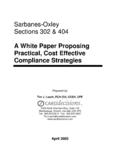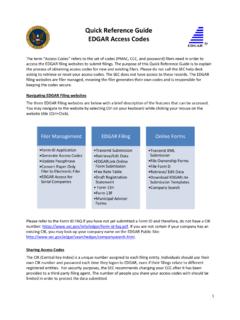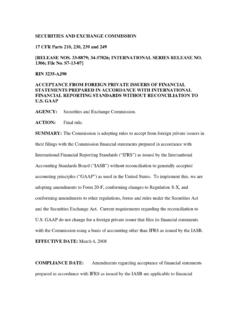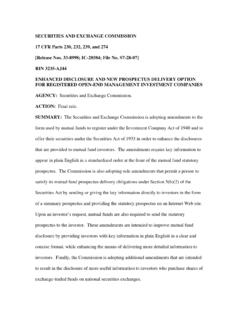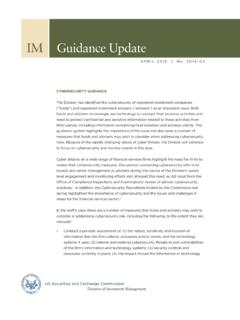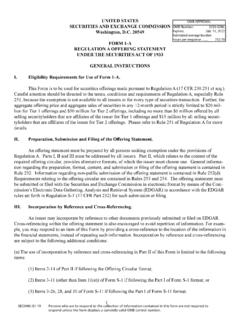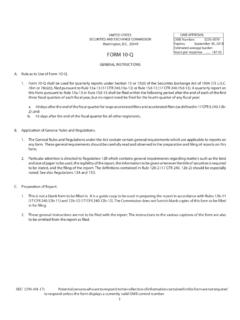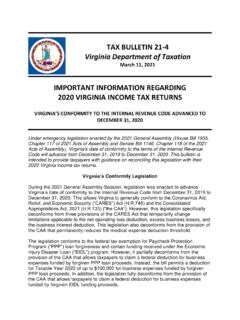Transcription of Investor BulletIn Interest rate risk — When Interest rates ...
1 Investor Assistance (800) 732-0330 BulletIn Interest rate risk when Interest rates Go up, Prices of Fixed-rate Bonds FallThe SEC s Office of Investor Education and Advocacy is issuing this Investor BulletIn to make investors aware that market Interest rates and bond prices move in opposite directions for example, when market Interest rates go up, prices of fixed-rate bonds may have noticed articles in the media about investors chasing yield, the so-called bond bubble, or predictions about declines in bond prices. some of these warnings about a drop in bond prices relate to the potential for a rise in Interest rates .
2 Interest rate risk is common to all bonds, particularly bonds with a fixed rate coupon, even treasury bonds. (Many bonds pay a fixed rate of Interest throughout their term; Interest payments are called coupon payments, and the Interest rate is called the coupon rate.)the purpose of this Investor BulletIn is to provide investors with a better understanding of the relationship among market Interest rates , bond prices, and yield to maturity of treasury bonds, in particular, although many of the concepts discussed below generally apply to other types of bonds as well.
3 This Investor BulletIn is a companion piece to our Investor Bulletins on Corporate Bonds, High-Yield Bonds, and Municipal Bonds. For a basic explanation of how bonds operate and their terminology, please see our Investor BulletIn on Corporate Effect of Market Interest rates on Bond Prices and YieldA fundamental principle of bond investing is that market Interest rates and bond prices generally move in opposite directions. when market Interest rates rise, prices of fixed-rate bonds fall. this phenomenon is known as Interest rate Assistance (800) 732-0330 seesaw, such as the one pictured below, can help you visualize the relationship between market Interest rates and bond prices.
4 Imagine that one end of the seesaw represents the market Interest rate and the other end represents the price of a fixed-rate Interest rates and Prices of Fixed-Rate Bonds Move in Opposite DirectionsHigher market Interest rates lower fixed-rate bond pricesLower market Interest rates higher fixed-rate bond pricesA bond s yield to maturity shows how much an Investor s money will earn if the bond is held until it matures. For example, as the table below illustrates, let s say a treasury bond offers a 3% coupon rate, and a year later market Interest rates fall to 2%.
5 The bond will still pay a 3% coupon rate, making it more valuable than new bonds paying just a 2% coupon rate. If you sell the 3% bond before it matures, you will probably find that its price is higher than it was a year ago. Along with the rise in price, however, the yield to maturity of the bond will go down for anyone who buys the bond at the new higher 1: If Market Interest rates Decrease by One PercentFinancial TermTodayOne Year Later Market Interest Rate3%2%Coupon Rate (semi-annual payments)3%3%Face Value$1,000$1,000 Maturity10 years9 years remainingPrice$1,000$1,082 Yield to Maturity3%2%Lower market Interest rates higher fixed-rate bond prices lower fixed-rate bond yieldsInvestor Assistance (800) 732-0330 suppose market Interest rates rise from 3% to 4%, as the table below illustrates.
6 If you sell the 3% bond, it will be competing with new treasury bonds that offer a 4% coupon rate. The price of the 3% bond may be more likely to fall. The yield to maturity, however, will rise as the price falls. EXAMPLE 2: If Market Interest rates Increase by One PercentFinancial TermTodayOne Year Later Market Interest Rate3%4%Coupon Rate (semi-annual payments)3%3%Face Value$1,000$1,000 Maturity10 years9 years remainingPrice$1,000$925 Yield to Maturity3%4%Higher market Interest rates lower fixed-rate bond prices higher fixed-rate bond yieldsFor a more detailed explanation of yield to maturity, including additional examples, please see our Investor BulletIn on Corporate Effect of Coupon rates on Interest Rate RiskInterest rate risk is common to all bonds, even treasury bonds.
7 A bond s maturity and coupon rate generally affect how much its price will change as a result of changes in market Interest two bonds offer different coupon rates while all of their other characteristics ( , maturity and credit quality) are the same, the bond with the lower coupon rate generally will experience a greater decrease in value as market Interest rates rise. Bonds offering lower coupon rates generally will have higher Interest rate risk than similar bonds that offer higher coupon fixed-rate bond coupon rates higher Interest rate riskHigher fixed-rate bond coupon rates lower Interest rate riskFor example, imagine one bond that has a coupon rate of 2% while another bond has a coupon rate of 4%.
8 All other features of the two bonds when they mature, their level of credit risk, and so on are the same. If market Interest rates rise, then the price of the bond with the 2% coupon rate will fall more than that of the bond with the 4% coupon :Lower market Interest rates higher fixed-rate bond prices lower fixed-rate bond yields higher Interest rate risk to rising market Interest ratesInvestor Assistance (800) 732-0330 of this relationship, it is particularly important for investors to consider Interest rate risk when they purchase bonds in a low- Interest rate Effect of Maturity on Interest Rate Risk and Coupon RatesA bond s maturity is the specific date in the future at which the face value of the bond will be repaid to the Investor .
9 A bond may mature in a few months or in a few years. Maturity can also affect Interest rate risk. The longer the bond s maturity, the greater the risk that the bond s value could be impacted by changing Interest rates prior to maturity, which may have a negative effect on the price of the bond. Therefore, bonds with longer maturities generally have higher Interest rate risk than similar bonds with shorter maturity higher Interest rate riskShorter maturity lower Interest rate riskto compensate investors for this Interest rate risk, long-term bonds generally offer higher coupon rates than short-term bonds of the same credit maturity higher Interest rate risk higher coupon rateShorter maturity lower Interest rate risk lower coupon rateIf you intend to hold a bond to maturity.
10 The day-to-day fluctuations in the bond s price may not be as important to you. The bond s price may change, but you will be paid the stated Interest rate, as well as the face value of the bond, upon maturity. on the other hand, instead of holding the bond to maturity, you might be able to sell the bond and reinvest the proceeds into another bond that pays a higher coupon Bonds are Subject to Interest Rate Risk Even If the Bonds Are Insured or Government GuaranteedThe seesaw effect between Interest rates and bond prices applies to all bonds, even to those that are insured or guaranteed by the government.


